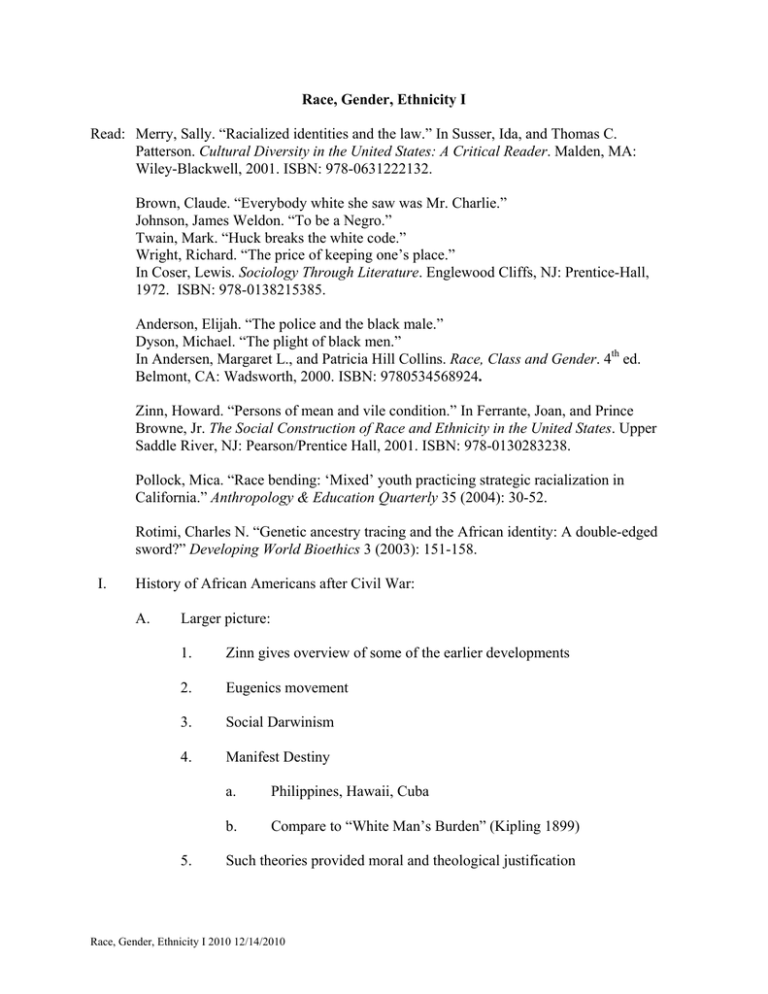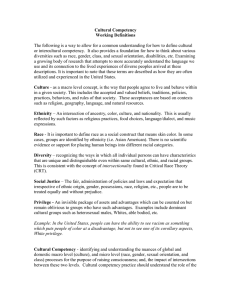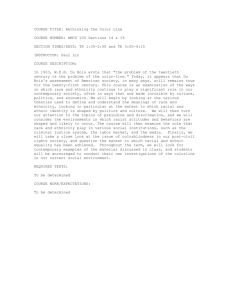
Race, Gender, Ethnicity I
Read: Merry, Sally. “Racialized identities and the law.” In Susser, Ida, and Thomas C.
Patterson. Cultural Diversity in the United States: A Critical Reader. Malden, MA:
Wiley-Blackwell, 2001. ISBN: 978-0631222132.
Brown, Claude. “Everybody white she saw was Mr. Charlie.”
Johnson, James Weldon. “To be a Negro.”
Twain, Mark. “Huck breaks the white code.”
Wright, Richard. “The price of keeping one’s place.”
In Coser, Lewis. Sociology Through Literature. Englewood Cliffs, NJ: Prentice-Hall,
1972. ISBN: 978-0138215385.
Anderson, Elijah. “The police and the black male.”
Dyson, Michael. “The plight of black men.”
In Andersen, Margaret L., and Patricia Hill Collins. Race, Class and Gender. 4th ed.
Belmont, CA: Wadsworth, 2000. ISBN: 9780534568924.
Zinn, Howard. “Persons of mean and vile condition.” In Ferrante, Joan, and Prince
Browne, Jr. The Social Construction of Race and Ethnicity in the United States. Upper
Saddle River, NJ: Pearson/Prentice Hall, 2001. ISBN: 978-0130283238.
Pollock, Mica. “Race bending: ‘Mixed’ youth practicing strategic racialization in
California.” Anthropology & Education Quarterly 35 (2004): 30-52.
Rotimi, Charles N. “Genetic ancestry tracing and the African identity: A double-edged
sword?” Developing World Bioethics 3 (2003): 151-158.
I.
History of African Americans after Civil War:
A.
Larger picture:
1.
Zinn gives overview of some of the earlier developments
2.
Eugenics movement
3.
Social Darwinism
4.
Manifest Destiny
5.
a.
Philippines, Hawaii, Cuba
b.
Compare to “White Man’s Burden” (Kipling 1899)
Such theories provided moral and theological justification
Race, Gender, Ethnicity I 2010 12/14/2010
2
a.
Albert J. Beveridge, Senator from Indiana commenting on
“liberation” of Cuba and Philippines:
The American Republic is a part of the movement of a race—the most masterful
race of history—and race movements are not to be stayed by the hand of man.
They are mighty answers to Divine commands. Their leaders are not only
statesmen of peoples—they are prophets of God. The inherent tendencies of a
race are its highest law. They precede and survive all statutes, all
constitutions…The sovereign tendencies of our race are organization and
government. 1
B.
C.
Reconstruction:
1.
Elected 2 senators, 20 Congressmen, numerous state officials
2.
Black-dominated legislatures created new and progressive state
constitutions
Jim Crow established by 1890s
1.
Synonymous with segregation, poll taxes, literacy tests, etc.
2.
The Democratic Party’s “White Primary” forbade black voting
3.
a.
Wasn’t against the law because Democratic party was a private
organization
b.
This ended the period of Reconstruction 2
In 1898 there were 130,000 Black registered voters
a.
D.
Politics of Accommodation emerged:
1.
1
8 years later only 1,342
Booker T. Washington:
a.
Willing to forego social equality until White people saw Blacks as
deserving of it
b.
Blacks should be educated because it would be a wise investment
for Whites
Quoted in Adalberto Aguirre, Jr. and David V. Baker, 2008. Structured Inequality in the United States: Critical
Discussions on the Continuing Significance of Race, Ethnicity, and Gender. 2nd ed. Upper Saddle River, N.J.,
Prentice-Hall, p. 19.
2
Richard T. Schaeffer, 2004. Racial and Ethnic Groups, 10th ed. Upper Saddle River, N.J., Prentice-Hall, p. 182.
3
c.
Whites liked him
d.
First time Blacks saw a leader achieve fame among whites
2.
Easy to criticize him now, but look at the context in 1900
3.
Lynchings, between 1889 and 1938 3,000 Blacks were lynched
a.
E.
F.
Black migration to urban North an important component
1.
Harder to ignore than as rural sharecroppers
2.
Black urban voter had potential power
DuBois’ Niagara movement ended up in the National Association for the
Advancement of Colored People (NAACP)
1.
G.
One was simply charged with “threatening and frightening” a
White woman 3
First time since pre-Civil War a merging of White liberalism and Black
militancy
WWII
1.
Black servicemen were segregated, but did serve
2.
A. Philip Randolph, president of Brotherhood of Sleeping Car Porters
a.
1941 threatened to lead 100,000 Blacks to Washington
1)
3
4
To ensure their employment
b.
New tactic of nonviolent direct action, inspired by Gandhi
c.
Roosevelt signed an executive order 4 prohibiting discrimination
3.
During the war there were riots, growth in civil disobedience
4.
Congress of Racial Equality (CORE) founded in 1942
5.
1947 “Freedom riders” test a court ruling prohibiting segregation in
interstate bus travel
Schaeffer p. 193.
Schaeffer, p. 195.
4
H.
Post-war period
1.
Jackie Robinson 1947 integrated major league baseball
2.
Supreme Court 1948 ruled that restrictive covenants were not
constitutional 5
a.
I.
3.
U.S. Army integrated 1950
4.
Brown vs. Board of Education of Topeka, Kansas
a.
Unanimous decision, Earl Warren, Thurgood Marshall
b.
Huge backlash—Little Rock 1957, cities closed schools
1)
Eisenhower: “I don’t believe you can change the hearts of
men with law”
2)
DISCUSS: can you?
But civil rights movement had begun:
1.
Freedom Riders
2.
Voter registration drives
3.
U Mississippi integrated by James Meredith
4.
Tactic of Civil Disobedience:
5.
5
Property owners agreeing not to sell to Jews, Blacks
Schaeffer p. 195.
a.
Rosa Parks refused to sit in the back of the bus: Montgomery Bus
Boycott 1956
b.
Martin Luther King, Jr.
Mass marches met with police dogs and high-pressure hoses on marchers
a.
Photographs were dramatic, appeared throughout the country
b.
Killings of the 3 civil rights workers and Medgar Evers received
nationwide attention
5
6.
Southern Christian Leadership Conference founded 1957
7.
1960: sit-ins, beginning in Greensboro, NC
8.
1961: Freedom Rides Alabama: national attention
9.
March on Washington in 1963
a.
10.
JFK assassination threw everything in doubt
11.
But Johnson signed Civil Rights Act, 1964
12.
J.
200,000 marched
a.
24th Amendment (no more poll taxes)
b.
Voting Rights Act 1965
c.
Fair Housing Act 1968
Federal vs. states:
a.
U.S. govt. arguing that killing a person violated that person’s civil
rights
b.
Grounds for prosecuting crimes southern states wouldn’t indict on
Continuing dissent
1.
SNCC Student Nonviolent Coordinating Committee
a.
“Freedom Now”; “Black Power”
b.
The phrase offended many Blacks and frightened Whites
c.
Shift in terminology is telling
2.
Beginning of identity politics
3.
Black Panthers
a.
Panthers’ self-presentation, rhetoric and programs alienated many
in Black community
b.
Panthers had many community service, outreach efforts
6
4.
II.
Later (1973) it came out that FBI systematic program
a.
To infiltrate civil rights groups in effort to discredit them
b.
COINTELPRO
1)
Counter-intelligence programs
2)
Tried to discredit dissent
What we have today:
A.
Say “race” and the black/white divide immediately comes to mind
1.
And, oh, yes, there are Asians and Native Americans
2.
Different in other countries (some do not use a classification system
anywhere near our concept of “race”)
3.
But anywhere the word “race” is used, “inferior” is included in the system
a.
4.
A system of social stratification
S. Africa under apartheid: official scheme was tripartite:
a.
Black, white, and “colored” composed of mixed white and black
b.
In South Africa, a revealing example of a categorization of
Chinese as “Asian” 6
c.
But the Japanese, economically important
1)
5.
B.
DISCUSS: U.S. terms for African Americans over time
Class or caste?
1.
6
Were “honorary Caucasians”
U.S. usually considered to have a “social class” system of stratification
a.
But arguments can be made that we also have a caste system with
the black/white divide
b.
DISCUSS: half the class argue in favor, half argue against
Carol R. Ember & Melvin Ember, Cultural Anthropology, 11th ed. Upper Saddle River: Pearson/Prentice Hall, p.
120
7
C.
III.
Dominant themes in U.S. Census classifications of race up until recently 7
1.
Preoccupation with skin color as definite indicator of race
2.
Belief in racial purity or in the idea that people can be classified as
belonging to one race
3.
A pattern of transforming many ethnic groups into one panethnic racial
group
4.
General tendency to admit no sharp distinction between race, ethnicity,
and national origin
Racism:
A.
Word was not used much before 1960s
1.
Before: problem seen as bigotry and discriminatory practices
2.
General view in America re: racial disparities and discrimination:
a.
3.
It’s a few bigots, and the deprived status of the Negro that are
causing racial tension
Not in terms of institutional racism
B.
But in fact part of a system of structured racial inequality
C.
Discrimination
1.
Has been a structural feature of U.S. society
2.
Racism manifests itself principally this way
a.
Rather than, as most people think:
1)
7
Through individual actions or conscious policies
D.
By end of 1960s, racism was understood to be a combination of prejudice,
discrimination, and institutional inequality
E.
Concept of structural violence
Joan Ferrante & Prince Browne, Jr., The Social Construction of Race and Ethnicity in the United States, 2nd ed.
2001. Upper Saddle River: Pearson/Prentice Hall, p. 8.
8
F.
1.
Where there is no perpetrator—is built into the system
2.
Example of experiment with 3rd graders (read) 8
3.
Hard for us to see
4.
Individualism a major part of our ideology
5.
Ku Klux Klan murdered the civil rights workers
a.
But the state of Mississippi refusing to indict the killers is
institutional racism
b.
Yes, there were individual decisions at this level, too, but that they
could get away with it is institutional racism, structural violence
Symbolic violence
1.
Omi & Winant: racial formation processes
a.
2.
DISCUSS: examples of symbolic violence?
a.
G.
DuBois
1)
Moment when he realized why children didn’t want to
exchange cards with him
2)
“I was different…shut out from that world by a vast veil.”
DISCUSS: Examples of:
1.
8
Occur through a linkage between social structure and cultural
representation
Readings for today or Jensen?
a.
Symbolic violence
b.
Individual prejudice leading to individual discrimination
c.
Structural violence
2.
Wright?
3.
“Momma” in the Brown piece?
Ferrante & Browne, pp. 5-7.
9
4.
Huck Finn?
MIT OpenCourseWare
http://ocw.mit.edu
21A.218J / WGS.170J Identity and Difference
Spring 2010
For information about citing these materials or our Terms of Use, visit: http://ocw.mit.edu/terms.







